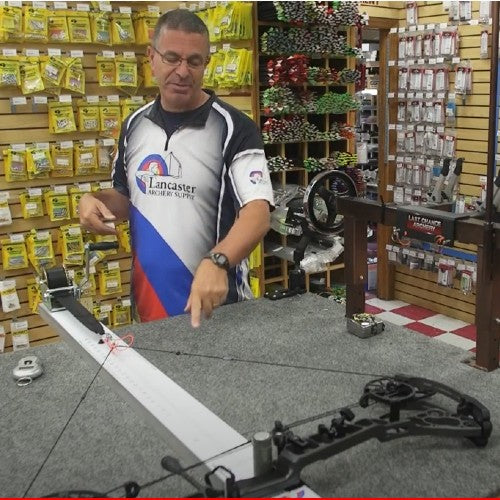More and more archers and bowhunters today are learning to work on their own equipment and acquiring the specialty tools needed to do that.
As you’re growing your home archery shop, one piece of equipment that’s a must-have is a draw board. It might seem extraneous at first, but the deeper you dive into archery tech work, the more you’ll appreciate having one.

What is a draw board?
It’s a tool that allows you to attach your compound bow and then draw back the string using a crank. So you can have your own bow locked in at full or half draw right in front of you, without anyone holding it - including you. That's going to spare your muscles and joints from unnecessary wear and tear.
There are a couple different kinds of draw boards. We make and sell a popular one here at Lancaster Archery Supply.
It’s a long aluminum “board” with a post on one end and a hand-cranked winch on. the other. A sticker on the face of the board has incremental measurements printed on it.

The LAS draw board is intended to be attached to a table.
Another popular style of draw board is one that attaches to a bow press. These types don’t actually include a “board” as part of their construction.

You attach a receiver arm that holds the bow to one end of a bow press and the winch to the other end.
To imitate your own draw as closely as possible, the winch straps for all draw boards include a hook that attaches to your D-loop. That hook is like your release.
For safety though, it’s always best to add a safety loop, just in case your D-loop fails. A safety loop can be just as simple as a tied circle of D-loop material that connects to your winch hook and wraps around the bowstring.

It should connect loose in that configuration so your hook pulls on the actual D-loop. The safety loop would only come into play if the D-loop fails to prevent dry-firing your bow.
What would you use a draw board for?
There are several tasks it can help you with, but arguably the most important is to check cam timing.
Making sure your cams roll over evenly and the draw stops hit the cables or limbs at the same time is critical to tuning your bow. Cams that aren't timed properly will cause arrows to porpoise when shot.

With a draw board, you can crank back the string and closely inspect that cam timing to see if adjustments are needed.
You can also attach a bow scale to the winch hook so you can measure your bow’s peak draw and holding weights using the draw board.
It’s a great tool for checking draw length. Target archers often want their draw lengths to be very specific measurements to fractions of an inch. The draw board allows you to check that yourself, with your bow at full draw.
Other popular uses of draw boards include inspecting cam lean, setting the timing for drop away arrow rests, setting peep height relative to an arrow at full draw and watching peep rotation.
The draw board is definitely a handy tool with multiple uses that you’ll want to consider for your home bow shop.
